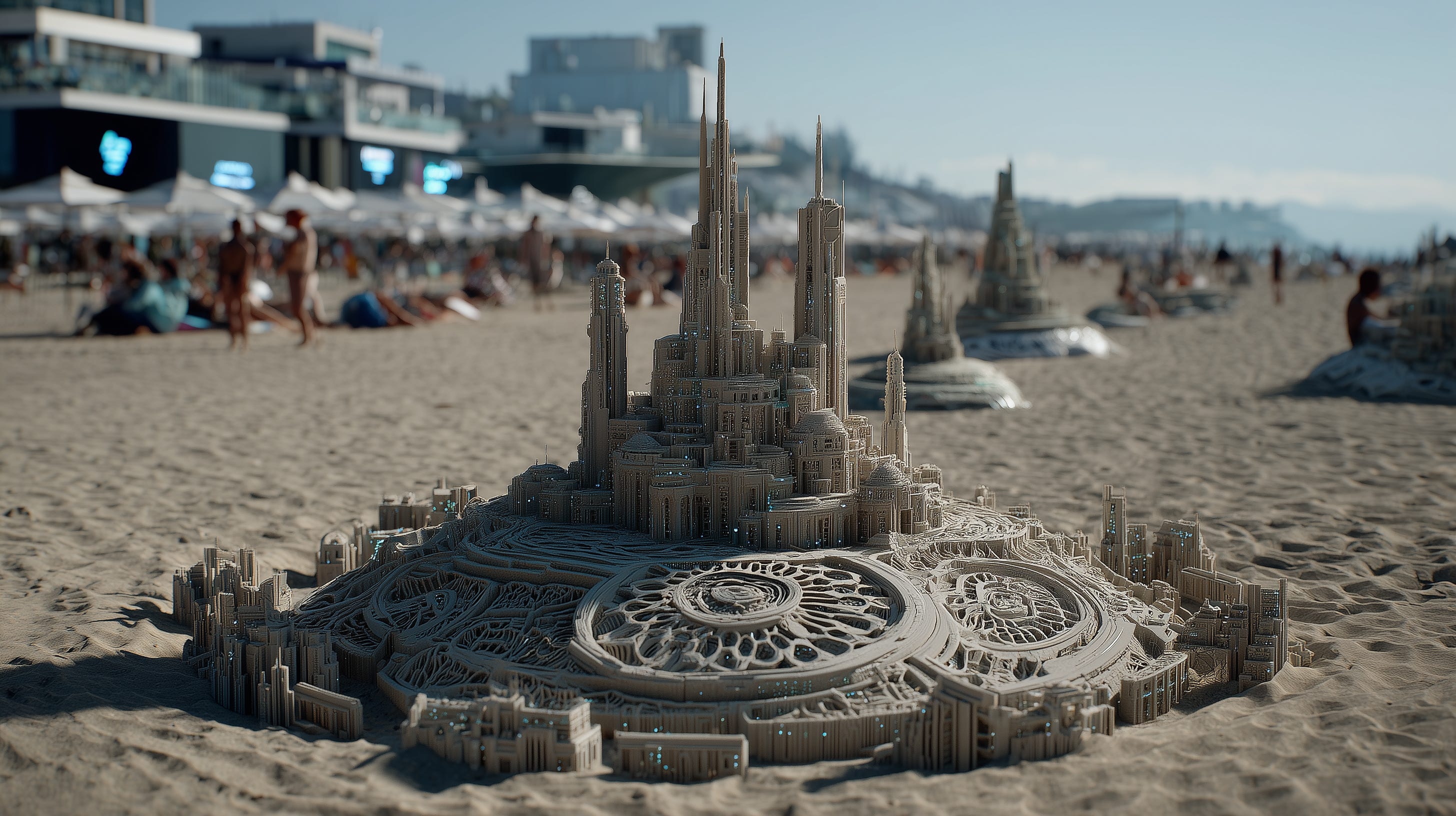The transport opens with a hiss, after a gentle stop in the shaded spot right at the sand. Thank you for choosing the beach-bound mobility network. The punch of hot air makes her appreciate even more the cooling clothes they had splurged on before the trip.
- Turn on the sunscreen. And make sure to take everything with you.
The family strolls down the ramp, surveying the beach beneath for an optimal spot. Their basket wagon glides behind them on spherical beach-ready wheels. At the beach level, an animatronic sand sculpture greets them, waving and squatting to air high-five the kids. Her daughter's eyes widen.
- Dad, how does it work?
- It’s a lot of tiny electromagnets making the sand look alive.
- Ok. Let’s go there!
Dad squints at the crowded beach.
- Too far.
- There!
- Too much sun.
The crowded beach is dotted with empty checkered spots with beach umbrellas. Each one is carefully maintained by the sand-sifting drones, which, with solar-powered patience, capture anything that could harm or discomfort the beachgoers.
- There!
- Too close to the water.
- Listen, gang, let’s just take the closest empty spot.
- There!
- These are reserved for volunteers swimming in sponge suits.
Two teenagers pose for photos in their suits swollen with captured microplastics, wearing their environmental service like badges of honour.
- Why can’t I get one?
- You need a few more years and you’ll get one. I promise.
As they walk past the lifeguard station, she glances at the black-and-white screen showing all the swimmers monitored by the safety buoys.
- Dad, are we streamtracking this?
- Sure thing but mood sensitive only.
- Great. That’s my favourite. Remember when we laughed so hard because Mum accidentally sat on a wet towel?
She smiles at the memory as they reach their spot.
- Ok. We’re here.
Her daughter points at the safety notice stamped in the middle.
- Why are those sharks on our spot?
- This is a reminder not to cross the shark barrier made of kelp and a magnetic field. It protects us from sharks and is better for the marine life than a net.
- Raaa! I’m a shark. I will bite your leg off.
- Stop scaring your sister and help me plug the fridge.
They take the cooler and plug it into the umbrella’s power outlet. The umbrella's surface shimmers with photovoltaic cells thin as soap bubbles, drinking in sunlight. She nods as a gentle ding confirms that the charging has started.
- Okay, let’s go swimming.
- No, we want to play first.
- Deal but remember: no swimming, no ice cream.
- Here, put on these AR markers so you won’t scare anyone, like you did yesterday.
She passes them the high vis floaters.
Kids put on the sunglasses and connect to the game.
- Okay. Okay. New competition starts in seconds. Hurry!
When the direct sun comes out from behind the clouds, her children's rashguards adjust to a more opaque setting, as they run to prepare their building spot.
- Have you ever noticed how sand castles got far more impressive since the kids started playing together, filling AR blueprints with sand?
- Mm-hmm. Should I update our privacy settings?
She reaches for her sunglasses.
- I don’t mind IDing myself in the pictures of strangers. It’s a lot of fun.
He shakes his head.
- It’s a waste of time.
- Don’t tell me you’re going to work now? I’m going to change and then want to enjoy the sea.
- I just need to check if the model has rendered properly, then we can swim.
She switches their beach umbrella to a dome mode. The umbrella's sides unfurl like a flower blooming in reverse, smart fabric flowing until they're enclosed in their beach pod.
- Deal. But if I beat you to it, I’m picking the dinner spot tonight.
- Deal.
She turns on the opacity, and their race begins.
Memories to build from this future:
1. Think back to when you first bought clothes that automatically adjusted to environmental conditions.
How did eliminating weather-related discomfort change your daily planning habits?
What new expectations did you develop for products that managed themselves?
How did your attitude to seasonal purchasing and storage change?
What happened to your energy level when one less thing required daily attention?
2. Try to recall launching the first service where customer needs were anticipated and fulfilled before explicit requests.
How did you redesign customer relationship management when AI predicted needs before customers recognised them?
What consent mechanisms did you create for acting on behalf of customers without direct authorisation?
How did you maintain customer agency when systems became increasingly predictive?
What two new service quality metrics did you create when proactive fulfilment became the baseline expectation?
Each memory from the future you build sharpens your strategic instincts for the decisions ahead.
Build enough memories.
Shape better futures.
Know a leader who could use more strategic creativity?
Share Practical Futures with your network.





